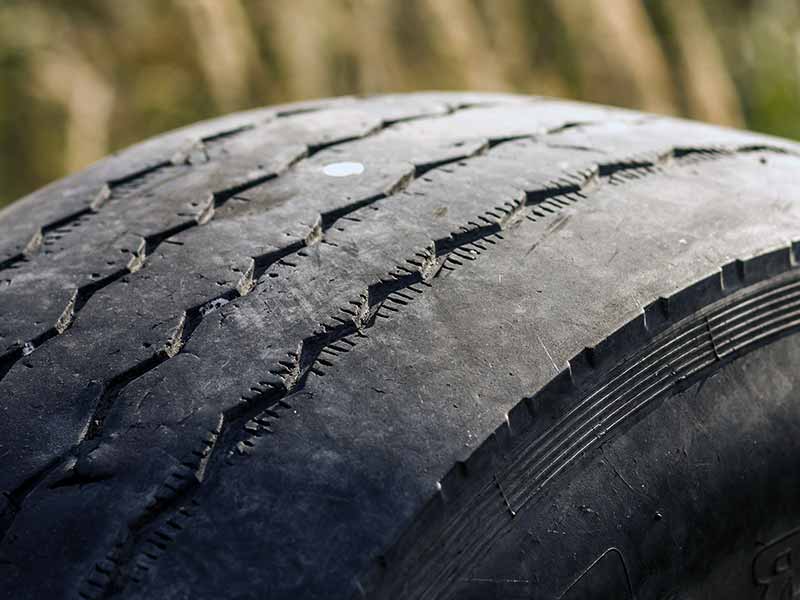Faster or uneven tire tread wear can sometimes be a challenge to diagnose and sort out. Wheel alignment, proper tire inflation, driving style, road surface, and many other factors can be incredibly important in how they affect tire wear.
Why Are My Tires Balding So Fast?
Improper wheel alignment, under inflated tires, and driving style are the most common reasons for excessive tire wear.
Regular tire rotation, getting your alignment checked, and insuring your tires are properly inflated will all go a long way toward making them last longer.
Most cars and trucks will wear the tires in uniquely different ways from one another. This adds a wrinkle to troubleshooting premature and uneven tire wear.
Let’s take a closer look
Faster Tire Wear Meaning
When you purchase a tire, it’s marked with a treadwear rating, which indicates how well the tire performed under standardized testing conditions. Although the treadwear rating doesn’t tell you exactly when the tire’s treads are going to wear out, it does help you understand how well a tire performs compared to other tires.
For example, a treadwear rating of 500 indicates that a tire’s tread should last five times longer under standardized testing conditions than a tire with a treadwear rating of 100. If the tread on your tires is wearing out faster than expected, it often indicates a problem with your vehicle’s alignment. Faster tire wear can also be caused by overinflation, underinflation, poor maintenance, and certain driving habits.
Uneven Tire Wear
Uneven tire wear comes in three varieties, all with different causes. When you examine your tires, look for the following:
- One-sided shoulder wear: Ribs are the raised sections of tread that you see when you look at a tire. In some cases, improper alignment causes an outside or inside shoulder rib to wear out much faster than the other ribs. This is known as one-sided shoulder wear.
- Feather edge wear: Feathering occurs when a rib is rougher on one side than the other. This type of wear is common in vehicles with alignment problems.
- Heel/toe wear: Tire tread comes in blocks. When one side of a block wears faster than the other, it’s known as heel/toe wear.
Alignment Problems
A vehicle’s suspension system helps absorb shock, preventing damage to your car. It also connects the wheels to the rest of the vehicle. Improper alignment of the suspension can lead to uneven tread wear, vibration in the steering wheel, and other symptoms. As the suspension springs, shocks, and other components of your suspension system age, they become less effective at absorbing shock, causing alignment issues. Your vehicle may also “go out of alignment” if you hit a large pothole, run into a parking block or bump into a curb with one of your tires.
Driving Habits
The way you drive has a big impact on the amount of friction between the road and your tires. Your driving habits may also affect your suspension system, especially if you frequently drive on streets filled with potholes. Here are a few habits that can cause your tires to wear out faster than expected.
- Taking corners too fast: Slowing down before you make a turn isn’t just a safety issue. It can also help you preserve your tires for as long as possible. When you don’t slow down enough, it takes more effort to stay on the road. This causes tire tread to wear away much faster than it would if you turned slowly.
- Sudden stops: Every once in a while, you need to slam on the brakes to avoid getting into an accident, but sudden stops shouldn’t be a normal part of your driving routine. Heavy braking may cause your brakes to lock up, causing you to skid to a stop. Skidding causes tire tread to wear away faster than expected.
- Hitting curbs: Nobody likes parallel parking, but you really should be careful when you’re parking along a curb. Even a little bump can cause alignment problems, leading to uneven tread wear and other problems.
- Accelerating too quickly: If you’re at a red light or a stop sign, be sure not to accelerate too quickly when it’s time to move through the intersection. If you “put the pedal to the metal,” your tires may spin before your vehicle gains traction. This spinning causes tire tread to wear away much faster than it should, reducing the life span of your tires.

Vehicle Model
The type of vehicle you have also affects your suspension system, which may lead to uneven tire wear over time. If you have a high-performance vehicle, such as a sports car, you’ll have to change the tires much faster than you would if you owned a station wagon or family-friendly SUV.
Not only do these vehicles have different suspension system designs, but your driving habits are also likely to vary from one vehicle to another. For example, you may take it easy while driving the kids to school in an SUV and then let loose when you’re behind the wheel of a sports car.
Overinflation or Underinflation
It’s important to keep your tires inflated to the recommended tire pressure, as any deviation above or below that recommendation can lead to premature tread wear. Tire pressure is measured in pounds per square inch (PSI), so if your owner’s manual has a recommended tire pressure of 32, that means each tire on your car should be inflated to 32 PSI.
Every month, you lose about 1 pound per square inch of air from each tire, making it vitally important to check your tire pressure regularly. You shouldn’t rely on your vehicle’s tire monitoring system, as it won’t alert you to small losses that could affect your tire tread.

Maintenance Habits
Regular maintenance is essential for keeping your tires in excellent condition. When you buy a new tire, you should have your wheels and tires balanced to ensure even tread wear on all four tires. It’s also important to have your tires rotated according to the manufacturer’s recommendations. If you have a problem with a tire, the manufacturer may deny your warranty claim if you can’t prove you had the tires rotated regularly.
Why Are My Front Tires Wearing Out So Fast?
In tire terms, “toe” refers to how a vehicle’s tires are angled. Tires that are turned in toward the center of the vehicle are said to have “toe-in,” while tires that are angled away from the center of the vehicle are said to have “toe-out.” If your front tires are wearing out quickly, it may be due to excessive toe-in. This can happen due to normal wear and tear on the components of your suspension system.
Front Tires Wearing On Inside
One of the most common causes of inside wear on front tires is a negative camber angle, which causes the tire’s angle to shift toward the center of the car. Front inside tire wear also occurs when a vehicle’s ball joints wear out. As ball joints age, they lose some of their grip on the wheels, putting more wear on the inside of the tires.
Front Tires Wearing On Outside
Aging coil springs are one of the most common causes of outside wear on front tires. As the coil springs age, they lose some of their height. This causes the vehicle to go out of alignment, putting extra stress on the outside of the front tires. Outside wear on your front tires may also be caused by the following:
- Bent struts
- Worn-out ball joints
- Damaged/worn control arm bushings
- Strut towers that are out of position
Why Are My Rear Tires Wearing Out So Fast?
On a vehicle, camber describes the tilt of the tire and accompanying wheel assembly. Positive camber is when the top of the tire leans outward, while negative camber is when the top of the tire leans inward. If your rear tires wear out quickly, it could be because of negative camber, an alignment setting that creates more friction between the road and the inner shoulder of each tire.
Rear Tires Wearing On The Inside
Common causes of inside wear on rear tires include worn-out ball bearings, alignment problems, and issues with other components of the suspension system. Overinflation or underinflation can also cause inside tread wear.
Rear Tires Wearing On The Outside
Although negative camber is a common cause of outside wear on rear tires, you can also see outside wear due to excessive toe-in. Worn or damaged suspension system components are also a common cause of outside wear on rear tires.
Which Tires Wear Faster?
The axle that drives your vehicle forward has a lot to do with which tires will wear more quickly. It should also be pointed out that different vehicles will have different alignment settings that can cause some tires to wear more quickly than others even when perfectly aligned.
The unique alignment settings and stresses that different drive orientations create will have a profound effect on tire wear.
Which Tires Wear Faster On FWD?
On a vehicle with front-wheel drive, the front tires wear slightly faster. This is because the front of the vehicle receives the brunt of the drivetrain forces. The front tires also take on much of the braking and steering forces, leading to faster tread wear.
Which Tires Wear Faster On RWD?
If your vehicle has rear-wheel drive, you can expect the rear tires to wear out slightly faster than the front tires. The extra wear comes from acceleration forces.
Which Tires Wear Faster On AWD?
On a vehicle with all-wheel drive, the front tires usually wear out slightly faster because they absorb most of the braking and steering forces.
Which Tires Wear Faster On A 4×4?
One of the main benefits of driving a 4×4 is that acceleration forces are distributed evenly among all the tires. That means acceleration affects all the tires the same way. Because the front tires handle the steering and braking, they tend to wear out slightly faster in a 4×4.
Resources
Below are some links you may find helpful when learning about tires
- Why are my tires wearing out faster than normal? – Your Mechanic
- Tire tread wear and causes – Bridgestone
Final Thoughts
Even when your tires wear evenly, they can wear more quickly than you feel they should. This is why it’s important to have your tires regularly rotated and ensure the air pressure of each tire is correct.
You’ll also want to have an alignment performed every 10,000 miles and have your mechanic do a thorough inspection of your suspension parts while they’re under your car or truck.
Ease up on the accelerator a bit and slow down through the turns to really slow premature tire wear. Even the most well-cared-for tires will have a short life if you’re constantly hooning around.
Good luck and happy motoring.





